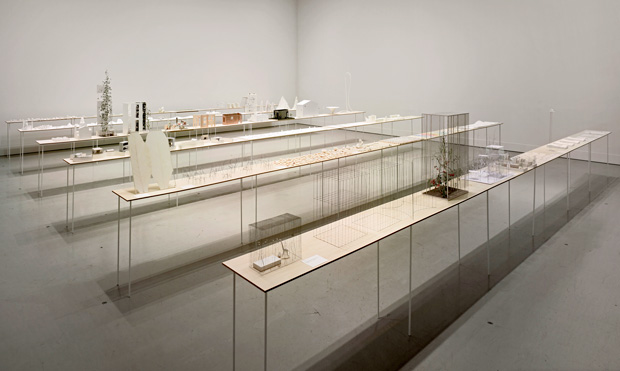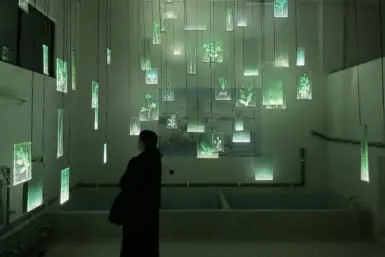by Owen Schaefer
It’s interesting that when people make reference to the ‘real world,’ they tend to be referring to its harsher realities: its ugliness, its limitations. Faced with the Utopian, the idealized, or the ambitious, many of us have a tendency to say, “It just won’t work in the real world.” I admit, it’s exactly the kind of sentiment I found myself repeating while looking at architectural models by Junya Ishigami. And it’s true—the Shiseido Gallery’s exhibition, How Small? How Vast? How Architecture Grows, features tiny wire-and-paper houses and miniature ceramic cities with impossible scales and proportions. It bears more resemblance to a gradeschool art fair than any serious consideration of housing in the ‘real world.’ But that may be exactly the point.
It is not practical buildings that Ishigami is interested in showing here. His work is more concerned with generating new ways of looking at architecture and pushing limits than discussing what is already possible. We may never live in narrow, string-like buildings that disappear into the sky, or have cities that stretch out like hedgerows between enormous natural fields, but should that stop us from considering it? Ishigami is a relatively fresh name in the world of architecture. His building credits include the Japanese pavilion at the 2008 Venice Biennale of Architecture and a building at the Kanagawa University of Technology. But he has also done a number of smaller projects which are architectural in concept only, such as a building-sized balloon polyhedron, balanced to float evenly in the air, and a three-millimeter-thick, nine-meter-long table that also seemed to defy gravity, or at least engineering.
In the face of these real accomplishments, the models in Ishigami’s current show at first appear almost ridiculous in their simplicity. Lined up on long tables, they are made of paper and cardboard, ceramic and wire, and have silhouetted figures of people and trees also cut from paper. Many of the designs are closer to city planning, since they consist of large empty fields dotted with buildings, represented by minuscule bits of ceramic. And as one might guess by the title of the show, there are no limits on the scale of Ishigami’s imaginings. On one table, a long, narrow bridge made of cardboard arcs up to two supports, charmingly held together by tape—a child’s vision of an otherwise standard bridge. But on closer examination, one realizes it is not a bridge for cars; the bridge itself is a city. The concept seems laughably fragile, but then so did Ishigami’s seemingly magical three-millimeter-thick table— nine meters long and perfectly flat.
I couldn’t help but feel it was shame that at least one or two of Ishigami’s real-life projects were not represented. It might have countered the feeling that all of his works exist in a fantasy world. The very real Kanagawa University building, with its paper thin roof and tree-like supports, is one example of a building that would be hard to imagine while looking at its paper model.
But then, perhaps the lack of real-world connections is the point. Ishigami seems to be indicating that if we are constantly thinking of what is possible, we will fail to achieve beyond the average—to think big enough or small enough, wide enough or narrow enough—to test the boundaries of what might one day become possible. How Small? How Vast? How Architecture Grows removes the worry of what we can do and focuses instead on what we want to do, making architects of us all.









